This post How can I extract elements from lists of lists in R? answers some of my questions but that still doesn't quite work for me and what I need to do goes beyond my R knowledge.
I have data from field trials in 2 environments (=trials), 2 years and 5 traits of interest (defined by trait_id). GID is the unique line identifier. My model in lme4 is:
mods <- dlply(data,.(trial,trait_id),
function(d)
lmer(phenotype_value ~(1|GID)+(1|year)+(1|year:GID)+(1|year:rep),
na.action = na.omit,data=d))
Running this returns a large list of 10 elements and I would like to store the random effects for GID for all traits per trial in a data frame. I tried several things:
blup=lapply(mods,ranef, drop = FALSE)
blup1=blup[[1]]
blup2=blup1$GID
will give me a df with the random effects for one trait per trial, I was hoping for something more streamlined that will preserve some of info like $irrigation.GRYLD in the column names.
Here is a reproducible example with only two traits (GRYLD, PTHT), 2 years (11OBR, 12OBR), and two reps:
structure(list(GID = structure(c(1L, 2L, 3L, 4L, 5L, 5L, 1L,
2L, 4L, 3L, 1L, 2L, 3L, 4L, 5L, 5L, 1L, 2L, 4L, 3L, 1L, 2L, 3L,
4L, 5L, 5L, 2L, 1L, 4L, 3L, 1L, 2L, 3L, 4L, 5L, 5L, 2L, 1L, 4L,
3L, 1L, 2L, 3L, 4L, 5L, 5L, 1L, 2L, 4L, 3L, 1L, 2L, 3L, 4L, 5L,
5L, 1L, 2L, 4L, 3L, 1L, 2L, 3L, 4L, 5L, 5L, 2L, 1L, 4L, 3L, 1L,
2L, 3L, 4L, 5L, 5L, 2L, 1L, 4L, 3L), .Label = c("A", "B", "C",
"D", "E"), class = "factor"), year = structure(c(1L, 1L, 1L,
1L, 1L, 1L, 1L, 1L, 1L, 1L, 1L, 1L, 1L, 1L, 1L, 1L, 1L, 1L, 1L,
1L, 1L, 1L, 1L, 1L, 1L, 1L, 1L, 1L, 1L, 1L, 1L, 1L, 1L, 1L, 1L,
1L, 1L, 1L, 1L, 1L, 2L, 2L, 2L, 2L, 2L, 2L, 2L, 2L, 2L, 2L, 2L,
2L, 2L, 2L, 2L, 2L, 2L, 2L, 2L, 2L, 2L, 2L, 2L, 2L, 2L, 2L, 2L,
2L, 2L, 2L, 2L, 2L, 2L, 2L, 2L, 2L, 2L, 2L, 2L, 2L), .Label = c("11OBR",
"12OBR"), class = "factor"), trial = structure(c(1L, 1L, 1L,
1L, 1L, 1L, 1L, 1L, 1L, 1L, 1L, 1L, 1L, 1L, 1L, 1L, 1L, 1L, 1L,
1L, 2L, 2L, 2L, 2L, 2L, 2L, 2L, 2L, 2L, 2L, 2L, 2L, 2L, 2L, 2L,
2L, 2L, 2L, 2L, 2L, 1L, 1L, 1L, 1L, 1L, 1L, 1L, 1L, 1L, 1L, 1L,
1L, 1L, 1L, 1L, 1L, 1L, 1L, 1L, 1L, 2L, 2L, 2L, 2L, 2L, 2L, 2L,
2L, 2L, 2L, 2L, 2L, 2L, 2L, 2L, 2L, 2L, 2L, 2L, 2L), .Label = c("heat",
"irrigation"), class = "factor"), rep = c(1L, 1L, 1L, 1L, 1L,
2L, 2L, 2L, 2L, 2L, 1L, 1L, 1L, 1L, 1L, 2L, 2L, 2L, 2L, 2L, 1L,
1L, 1L, 1L, 1L, 2L, 2L, 2L, 2L, 2L, 1L, 1L, 1L, 1L, 1L, 2L, 2L,
2L, 2L, 2L, 1L, 1L, 1L, 1L, 1L, 2L, 2L, 2L, 2L, 2L, 1L, 1L, 1L,
1L, 1L, 2L, 2L, 2L, 2L, 2L, 1L, 1L, 1L, 1L, 1L, 2L, 2L, 2L, 2L,
2L, 1L, 1L, 1L, 1L, 1L, 2L, 2L, 2L, 2L, 2L), trait_id = structure(c(1L,
1L, 1L, 1L, 1L, 1L, 1L, 1L, 1L, 1L, 2L, 2L, 2L, 2L, 2L, 2L, 2L,
2L, 2L, 2L, 1L, 1L, 1L, 1L, 1L, 1L, 1L, 1L, 1L, 1L, 2L, 2L, 2L,
2L, 2L, 2L, 2L, 2L, 2L, 2L, 1L, 1L, 1L, 1L, 1L, 1L, 1L, 1L, 1L,
1L, 2L, 2L, 2L, 2L, 2L, 2L, 2L, 2L, 2L, 2L, 1L, 1L, 1L, 1L, 1L,
1L, 1L, 1L, 1L, 1L, 2L, 2L, 2L, 2L, 2L, 2L, 2L, 2L, 2L, 2L), .Label = c("GRYLD",
"PTHT"), class = "factor"), phenotype_value = c(3.93, 3.38, 1.65,
4.33, 2.45, 2.48, 3.98, 3.3, 4.96, 1.53, 87.5, 69.5, 65.5, 84.5,
77, 81, 94.5, 84.5, 89, 81, 6.56, 4.3, 5.76, 7.3, 5.73, 4.14,
5.93, 6.96, 8.43, 5.81, 114.5, 100, 104.5, 110, 110, 106, 99,
97.5, 105, 100, 0.119, 0.131, 0.681, 0.963, 0.738, 1.144, 0.194,
0.731, 0.895, 0.648, 35, 50, 45, 50, 45, 50, 55, 45, 50, 55,
2.79, 3.73, 3.96, 4.64, 5.03, 2.94, 3.78, 4.14, 3.89, 3.21, 90,
95, 105, 100, 105, 85, 95, 100, 100, 95)), .Names = c("GID",
"year", "trial", "rep", "trait_id", "phenotype_value"), class = "data.frame", row.names = c(NA,
-80L))
